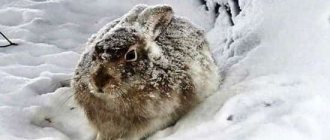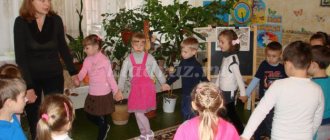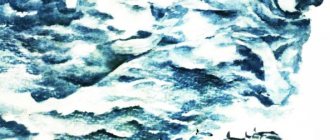Animals begin to prepare for winter during the warm season.
In the fall, squirrels can be seen carrying nuts into their hollows or burying them in the ground, only to dig them up a few months later for a winter snack.
Mice and beavers bring extra food into their homes to have food when it gets too cold, and bees store honey all summer and fall. Most mammals eat extra fat during the warm months to last through the winter. It will not only warm them during the cold season, but will also not leave them hungry.
Other animals adapt to winter weather by changing their appearance. The fur becomes thicker and heavier just as we change from an autumn jacket to a winter one. Animals such as the rabbit and the Arctic fox completely change the color of their fur, going from dark colors in summer to white in winter. This property sometimes saves their lives, because... allows them to better camouflage in the snow, making them more invisible.
Some animals are preparing for winter hibernation. For example, bears, skunks, and hedgehogs prepare cozy dens and sleep almost all winter. They enter a state of torpor, which transitions into a state of reduced physiological activity, allowing them to reduce their body temperature and metabolic rate. This allows them to survive without much food. Others, such as chipmunks, marmots, bats and even snakes, fall into an even deeper sleep, where their bodies become still for months, often not waking up until spring. This allows animals to save energy and not have to worry about food and cold for a while. They wake up hungry and often unhappy, but at least they were able to escape the worst of the weather.
Some creatures don't want to deal with winter at all! Instead, they move to places where they can easily find food and not freeze from the cold. This is called migration. Caribou and some species of deer make winter treks, as do whales and some fish, which swim long distances in search of warmer water. Even monarch butterflies fly from Canada and the United States to Mexico in search of sunnier days. In the spring, migration occurs in the opposite direction, to where winter has finally ended.
Let's look at preparing some animals for winter in more detail.
Who is first?
Nature has created separate “schedules” for various animals to organize for the winter.
Some forest dwellers begin to prudently think about cold weather not in late or early autumn (like other animals). They carry out procurement work already in the summer.
In what order do different mammals come up with the idea of preparatory activities? Rodents - wood mice, chipmunks and gophers - think about winter before others. And also boibaks (inhabitants of the “borderland” of the green area - the so-called forest-steppe). After them, fellow hamsters come into play, carrying tasty reserves in their mouths from September 1st. Squirrels (part of the same zoological community) act only at the height of Pushkin's time.
The next category of inhabitants of fragrant green thickets is the hedgehog family. They also don’t wait until the 12th month, trying to finish the important matters mentioned already in the 10th or 11th.
Only after the rest of the inhabitants of the dense tree stand do predators and the hare remember the upcoming frost and the accompanying hunger. Some are not going to work at all in winter. Better sleep.
Let's talk about how animals prepare for winter, revealing the nuances of the work of 4 zoo families.
Thrifty jays and predatory beauties
For the most part, birds do not prepare for the cold, but simply continue to lead their usual lifestyle and look for food. However, there are species that make reserves. For example, a jay. These forest birds stock up on acorns for the winter, which they put in different places (mostly buried under trees), and half of the storehouses are simply forgotten. Some acorns germinate successfully, so thanks to these birds there are more oak trees in the city.
Graceful birds of prey, which you cannot feed by hand, also remain to spend the winter. The largest of them is the goshawk. Most often he hunts pigeons, ducks or blackbirds. The migratory sparrowhawk, which catches sparrows, tits and blackbirds, also waits out the cold in the capital. These birds do not need nests and sleep on the branches of coniferous trees, where they hide from prying eyes, so it is very difficult to see them.
For example, this year goshawks were spotted in all large forest parks of the capital, such as the natural and historical parks “Tsaritsyno”, “Moskvoretsky”, “Kuzminki-Lublino”, “Bitsevsky Forest”, the natural reserve “Valley of the Setun River” and the landscape reserve “ Butovsky." And we saw a sparrowhawk in the Zelenogradsky complex reserve, in the territories of the Serebryany Bor natural monument and the Altufevsky complex reserve, in the Kominsky, Izmailovo, Tsaritsyno, Kuzminki-Lublino, and Bitsevsky forest natural areas. , as well as in the Butovsky landscape reserve.
“Of the nocturnal birds of prey, various species of owls winter in Moscow—the great owl, the long-eared owl, and the gray owl. Long-tailed and great gray owls are less common, and polar owls fly to Moscow every 10–15 years. There is a lot of food for them here - rats, mice and squirrels. If deep snow falls in the forest and crust forms, then the birds may die of starvation, but this does not threaten city residents. Here the roads are cleaned and there are garbage containers - practically a “buffet” for birds of prey,” notes Nikolai Kudryavtsev.
How squirrels and beavers prepare for winter
Squirrels live in hollows - deep voids located in tree trunks. And at a high altitude. For protection from arrogant predators. Amazingly agile owners of ears with tassels put nuts and other delicacies that they love so much there. Acorns, mushrooms and a variety of seeds are also good for nutrition.
Among the toothy ones, God awarded the beavers with the most powerful oral incisors. And so they quickly and skillfully build housing (it is always on the water - the forest itself floats into their teeth). And beavers live in large families. Therefore, they are able to build both a classic (summer) hut and winter (insulated) “apartments”. The food warehouse in the “January towns” is a pile of small branches and roots of aquatic flora. It remains to add that the dams are thoroughly strengthened closer to frost. Repairs are underway.
Someone is sleeping and someone is awake
Animals that hibernate have either already fallen asleep until spring, or are just getting ready to do so.
“In Moscow, snakes, lizards and such cute rodents as hazel dormouse are already dreaming. Newts traditionally settled in fallen leaves near the water, and frogs, depending on the species, buried themselves in the mud at the bottom of reservoirs or hid in shelters on land,” says Svetlana Podvintseva, head of ecology at Mospriroda State Budgetary Institution.
With the first frosts, hedgehogs, which by this time have gained weight and grown a fur coat, also go into hibernation.
However, there are those who, even in the winter cold, continue to lead an active lifestyle. These are squirrels, hares (hare and hare), foxes, beavers, muskrats and mouse-like rodents, including the most common species - the field mouse. By winter, they are insulated with undercoat, and some change color. Foxes also acquire fluffy fur coats, and in winter they become real forest beauties. As for the hares, they change the color of their coats and switch to a winter diet: it becomes very difficult to get to last year’s grass, so they have to eat what’s left: branches and bark.
Squirrels traditionally store provisions in hollows or bury food in the ground. They begin preparations at the end of summer by collecting nuts, mushrooms and berries. Later, the animals change the color of their fur coat from summer red to winter gray. In cold weather, squirrels try not to be active - most of the time they sit in hollows, and only come out to eat.
Mouse-like rodents also store plant seeds in their burrows. In winter, they build tunnels under the snow and try to stay close to the feeders. The river beaver, which is listed in the Red Book, also collects food. Animals actively cut down trees, since they have no other way to get to young branches.
“At the same time, beavers try to knock down the tree into the water - there, in their native element, it is easier and safer for them to collect branches. The animals put them in the hut and storerooms. Three or four families of beavers live on the Setun River, and on its tributary Aleshinka they built the largest dam in Moscow, 10–11 meters long,” says Nikolai Kudryavtsev.
Muskrats are less fortunate - they cannot cut down trees, but they need to stock up on food. For this reason, they pay more attention to aquatic plants. Sometimes the proximity to beavers helps, as, for example, on the Khimka River in the Pokrovskoye-Streshnevo Park.
Few people know, but moles don’t sleep in winter either. They stock up on earthworms and prepare for harsher conditions.
Preparing hedgehogs
Animals can carry supplies for the winter directly on their backs (without using their limbs, but using needles). And the conversation, as you guessed, is about hedgehogs. Seeing “fallen” apples and high-calorie “forest meat” (mushrooms), these cunning creatures turn into a particularly prickly ball and roll over their finds. They literally pin them on their backs.
But it’s not only the food listed that hardworking hedgehogs bring to their winter nests. In the cold, they are not averse to pampering themselves with fat caterpillars, suddenly numb (at the sight of a ball rolling on them) toads and mice. You just need to collect all this yummy stuff in the fall - before it’s under the ice.
Yes, yes - a harmless-looking hedgehog is actually a predator. Then, when he sees someone smaller. By the way, it eats snakes, worms and generally anything that crawls. Many died. Take it - I don’t want it.
But that's not all. The animal is so picky in terms of comfort that it also rebuilds its housing. In order not to tremble and toss and turn in the next 3 months. Insulates the ground nest with dry leaves, makes an orthopedic mattress useful for the spine - it carries pliable but elastic forest moss.
Not all migratory birds
During the warm season, 245 species of birds live in the capital, but only about 90 of them remain for the winter. In the first half of November, not all migratory birds have yet left for warm countries. For example, in Moscow you can still find chiffchaffs, redstarts, finches, bramblings and blackbirds of various species. Migration ends by December, so they will soon fly south. However, in rare cases, individual individuals remain in Moscow for the winter.
With the onset of cold weather, birds can gather in mixed flocks to search for food together and protect themselves from predators. For example, in one “team” there are a great spotted woodpecker, a nuthatch, a pika, a great tit, a blue tit, a plume and a wren. In what experts say is a flock of tits (or “loose”), they move through parks, squares and forests.
“It’s easier to survive in winter in such a flock. This way, birds find food faster, and if a predator approaches, they give an alarm signal and everyone scatters,” explains Nikolai Kudryavtsev, head of the department of environmental education and animal registration of the directorate of natural areas “Valley of the Setun River” of the State Budgetary Institution “Mospriroda”.
According to him, most often on the streets you can find the hooded crow, jackdaw, house sparrow, and rock pigeon. It is these birds that live in the city all year round and usually flock to feed.
“There are a lot of tits too. All five species remain in Moscow for the winter - the plume tit, the black tit, the blue tit, the long-tailed tit and the common tit. But the blue tit, listed in the Red Book of Moscow, is practically never found here. She is attracted to the distant Moscow region in the area of Lotoshin and Volokolamsk,” says Nikolai Kudryavtsev.
In addition, woodpeckers, who do not change their taste preferences throughout the year, also choose Moscow for wintering. Only the gray-haired woodpecker often goes on a berry diet in cold weather, since it is easier to find berries than larvae. The zhelna, or black woodpecker, also remains here - this is the largest woodpecker in Russia, which is listed in the Red Book of Moscow.
Muscovites also often feed waterfowl, for which the presence of open water bodies is important. The most common time to see mallards is in the winter. Other species are less common, including large and medium-sized mergansers, chickweeds, ducklings, long-tailed ducks, black ducks and other northern ducks.
How does a hare prepare for winter?
Some preparation of animals for winter consists only of changing the spring-summer wardrobe to a much warmer winter one. As soon as deep snow falls on the ground, it’s time for the scythe to change his clothes. By that time, the last shreds of his summer coat had already left his timid little body (our great-grandfathers dubbed this process “molting”).
But at the same time new fur grows. Dense and fluffy. Able to retain as much heat generated in the body as possible. Between its VILLS (“vols”, “lint” or “bors” - fur in old languages). However, in order for the warmth itself to be born inside the animal, it needs to eat well. In cold weather, the hare gnaws the bark of trees, because he does not know where to carry supplies (“he does not have a registration - he runs back and forth all year long”). Winter wool is a camouflage robe. White. Try to find it.
Preparing bears for cold weather
The bear, on the contrary, has already chosen housing. It will be difficult to get him out of there. Only with the help of the bark of a hunting dog or the poke of a large pike. The original Slavic-Baltic-Germanic name of the beast sounded like “ber”. He is preparing for the “white season” in November. He finds a hole, which he turns into a “log” (“log” in the original translation “place of lying”). That is why, although we already call the giant himself “honey” (“knowing about honey”), we still designate his hibernation place as “ber loga.”
Loga is a direct synonym for the word “log”; it is a natural excavation in the ground (pit). It is precisely these cavities that clubbed couch potatoes equip for their winter bedroom, lining the walls with moss, branches, leaves or dead coniferous trees (if we are talking only about the taiga). Where's the food? Already inside himself. In a state of suspended animation, the bear sucks its paw, through special pores of which fat penetrates. And it was carefully accumulated from April to October inclusive.
Finally, I would like to summarize. Some predators (wolves, foxes, lynxes) are busy hunting (and, in fact, searching for food) even in December, January and February. All preparation for the snow season, for example, for a fox, consists of changing its skin (like a hare, it changes it to a warmer one). The bear does not need food supplies (they are inside him).
Why is this happening? Predators are not afraid of anyone and create shelters only for the period of breeding. The exception is the fox, which sometimes hides in holes from specially trained hunting dogs. However, even many cowardly representatives of the fauna do not like winter shelters. The hare, for example, relies on its legs. And, on the contrary, the bear, which seems to be the most fearless, hides in a den. Not for fear of being eaten! Because of the fear of the cold, which could kill in a dream. Animals are divided into thrifty, sleeping and changing fur.
Help for birds and animals
With the onset of cold weather, the food supply of birds is greatly reduced, and energy losses increase. This is a very difficult period, so there is no need to feed too much, but only if the food is correct. Experts recommend treating birds with raw sunflower seeds and different types of nuts. For ducks, you can grab rolled oats, but you need to pour it on the shore and not into the water. They also happily eat seeds, corn and special food for waterfowl. It is important to remember that bread is bad for them. Black rye bread, as a rule, causes fermentation in the stomach of birds. But it is better to give white bread dried and crushed, since fresh bread is harmful to the digestive system of birds.
As for animals, most of them do not need feeding in the winter; they can get their own food. You can only help in severe frosts, when it becomes harder for animals to find food. In addition, experts periodically leave food in the forests during difficult times. They also lay out salt for moose and wild boars.








